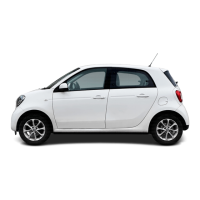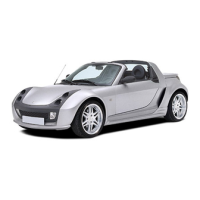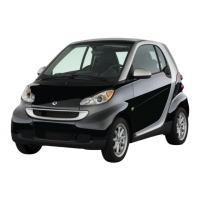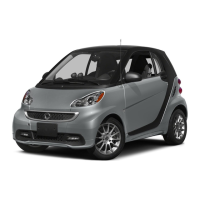Restraint system response during an
accident
The way the restraint system responds
depends on the severity of the impact detec-
ted and the apparent type of accident:
R
head-on collision
R
rear impact
R
side impact
The activation threshold for the restraint
system components is determined based on
the analysis
of the sensor values measured at
various points in the vehicle. This process is
pre-emptive in nature. The triggering/
deployment process should take place in good
time at the start of the collision.
Factors which can only be seen and measured
after a collision has occurred do not play a
decisive role in the deployment of an airbag,
nor do they provide an indication of airbag
deployment.
The vehicle may be deformed significantly
without an airbag being deployed. This is the
case if only parts which are relatively easily
deformed are affected and the rate of vehicle
deceleration is not high. Conversely, an air-
bag may be deployed even though the vehicle
suffers only minor deformation. If, for
instance, very rigid vehicle parts such as
longitudinal body members are hit, the rate
of vehicle deceleration may be sufficient.
The restraint system components can be acti-
vated or triggered independently of each
other:
Component Detected trigger
situation
Belt tensioners: Head-on collision,
rear impact, side
impact
Driver's airbag,
front-passenger
front airbag and
knee bag
Head-on collision
Sidebag side impact
G
WARNING
After the airbag deploys, the airbag parts
are hot. There is a risk of injury.
Do not touch the airbag parts. Have a
deployed airbag replaced at a qualified
specialist workshop as soon as possible.
i
smart recommends
that you have the vehi-
cle towed to a qualified specialist work-
shop after an accident. Take this into
account, particularly if a seat belt ten-
sioner was triggered or an airbag was
deployed.
If the belt tensioners are triggered or an
airbag is deployed, you will hear a bang, and
a small amount of powder may also be
released:
R
The bang will not usually affect your hear-
ing.
R
In general, the powder released is not haz-
ardous to health but may cause short-term
breathing difficulties to persons suffer-
ing from asthma or other pulmonary condi-
tions.
Provided it is safe to do so, leave the vehi-
cle immediately or open the window in
order to prevent breathing difficulties.
Seat belts
Protection provided by seat belts
Always fasten seat belts correctly before
starting your journey. A seat belt can only
provide maximum protection when worn cor-
rectly.
G
WARNING
If the seat belt is worn incorrectly, it can-
not perform its intended protective func-
tion.
Furthermore,
an incorrectly worn seat
belt can cause additional injuries, e.g. in
the event of an accident, heavy braking or
sudden changes of direction. There is an
increased risk of injury, possibly even
fatal.
Always ensure that all vehicle occupants
have their seat belts fastened correctly and
are sitting properly.
Occupant safety
29
>> Safety.
Z

